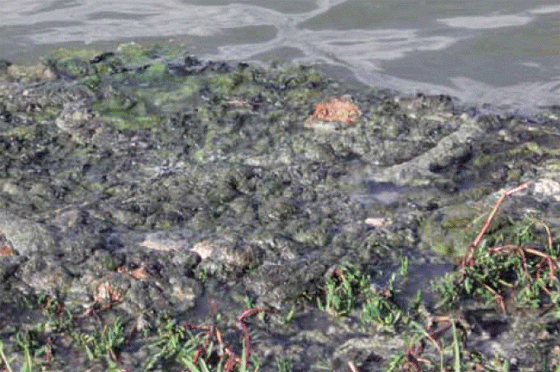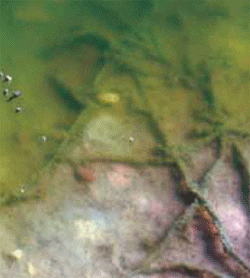
Widespread pollution of the oceans is
a serious problem, and all indications are
that dead zones a direct result of excess
nutrients promoting the growth of algae
that in turn utilize all of the oxygen present
in an area are increasing in occurrence.
As of 2011, more than 500 of
these zones had been identified.
It is highly likely that many more
areas are in decline due to pollution. The
constant addition of nutrients from billions
of tons of untreated human sewage,
agricultural run-off and industrial waste are slowly strangling the ability of the
oceans to cope. The intensification of
aquaculture systems in Southeast Asia
may also contribute.
Blue-Green Algae
Blue-green algae (cyanophytes or cyanobacteria)
sit on the phylogenetic fence
between being bacteria and algae, with an
ongoing tug of war among taxonomists as
to which group they belong. They are
accurately characterized as photosynthetic
bacteria.
Blue-green algae are widely viewed as
indicators of pollution, and their presence
in aquaculture production systems at high
numbers is a sign that the systems are not
being properly managed. When influent
comes from areas that are in preliminary
dead zone stages, heavy nutrient loads
and undesirable algal species can be
pumped into production areas.
Toxins
Perhaps the single greatest threat
from these algae is the toxins they produce.
Many toxins have been characterized,
including neurotoxins, hepatotoxins,
cytotoxins and dermatotoxins. Some are
widely documented, such as the micromicrocystins
and nodularin that can cause liver
damage, geosmin responsible for off-flavor,
and beta-methylamino-L-alanine
(BMAA), a potent toxin produced by
many species that has been linked to several
serious brain diseases, including amyotrophic
lateral sclerosis (ALS) and
Alzheimers.
While many strains are benign, many
strains are not. They pose a serious threat
to animal health and potentially to consumers
if they are present in farmed
product. No regulations require screening
for some of the more potent toxins. It is
highly probable that they are present to
some extent in some animals.
A number of algae species have been
implicated in fish kills and, to a lesser
extent, shrimp die-offs. Bearing in mind
that they are ubiquitous and that shrimp
are routinely farmed in waters that contain
blue-greens, it is likely their presence
is impacting productivity. Animals that
ingest these toxins may not die, but can
be weakened, increasing their susceptibility
to pathogens. The presence of algae
can also impact growth rates and feedconversion
ratios.

Impacts On Shrimp Farming
Recent reports from Southeast Asia
suggest a number of potential toxins at
work in many different countries might
be killing shrimp during the first days
after stocking. The pathology is consistent
with that of a hepatotoxin, and several
studies have implicated a role of benthic
materials in this process.
It is a common practice to kill incoming
algae, zooplankton and other planktonic
organisms by the use of chlorine.
This is primarily done to lessen the risk of
introducing viral vectors into the ponds.
Many blue-greens release toxins upon
death and settle to the bottom as they die
off. Postlarval shrimp feeding on the benthos are exposed to these toxins. A number
of the toxins are biodegraded by the
action of natural bacteria in the ponds and
typically no longer cause biological
impacts. Some, however, persist and
impact animals directly and indirectly.
It is critical for both short-term production
and long-term culture success
that the presence of these algae as well as
their environmental loads are kept to a
minimum. While low-level mortality and
gradual attrition in the culture environment
are likely results of the presence of
these toxins, they pale against the potential
risks to consumers of farmed products
containing toxic material.
Management
There are a number of potential solutions
to algae problems, and it is always
in the best interests of farmers to minimize
the presence of blue-green algae in
their production systems. Killing them
outright can be problematic, however. It
makes much more sense to proactively
manage their presence by managing production
systems to ensure a proper balance
of nutrients.
Discharging waste products from
intensive culture systems is a poor practice.
Best practices dictate that these
wastes be collected and digested using the
same technologies that are currently used
to degrade sewage.
The risks due to algae are real and
need to be proactively managed. Enzymelinked
immunosorbent assay-based tools
allow suspect animal tissues to be tested
for the presence of potentially harmful
toxins. Many of these toxins are readily
metabolized, although in some cases, their
presence even at very low levels can stress
animals and lead to both production and
potential consumer problems.
September 2012




